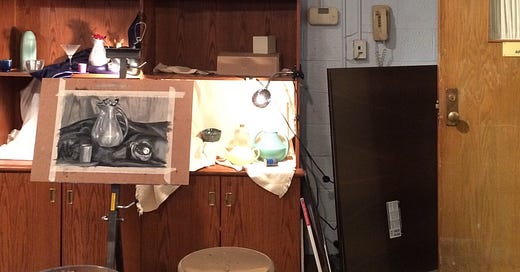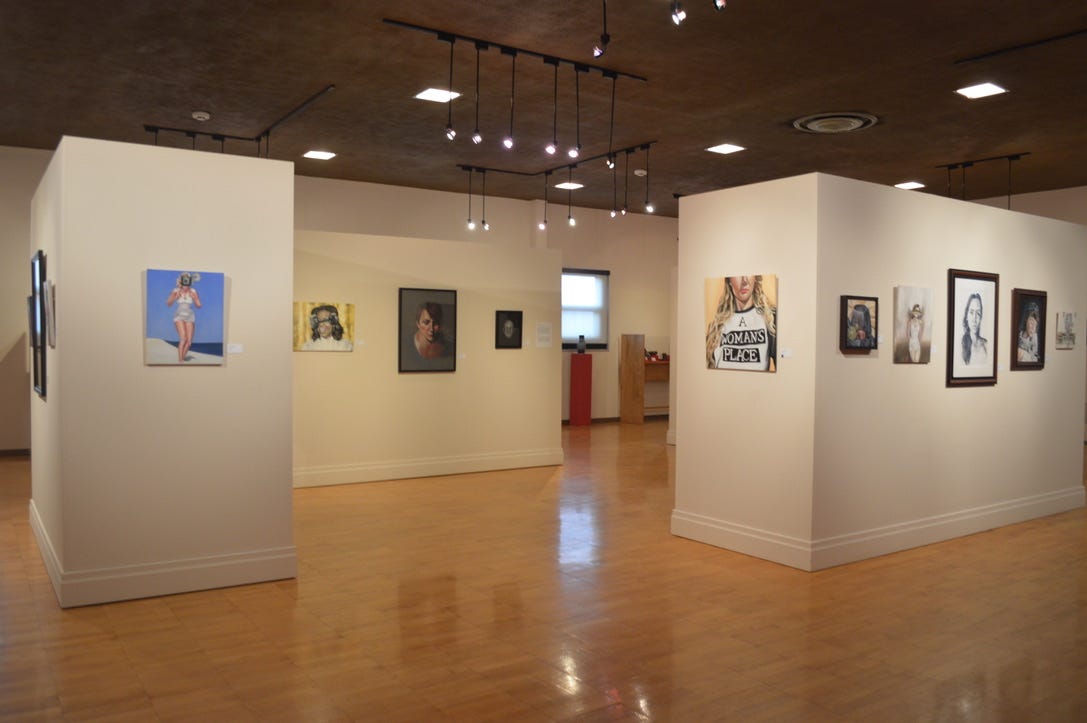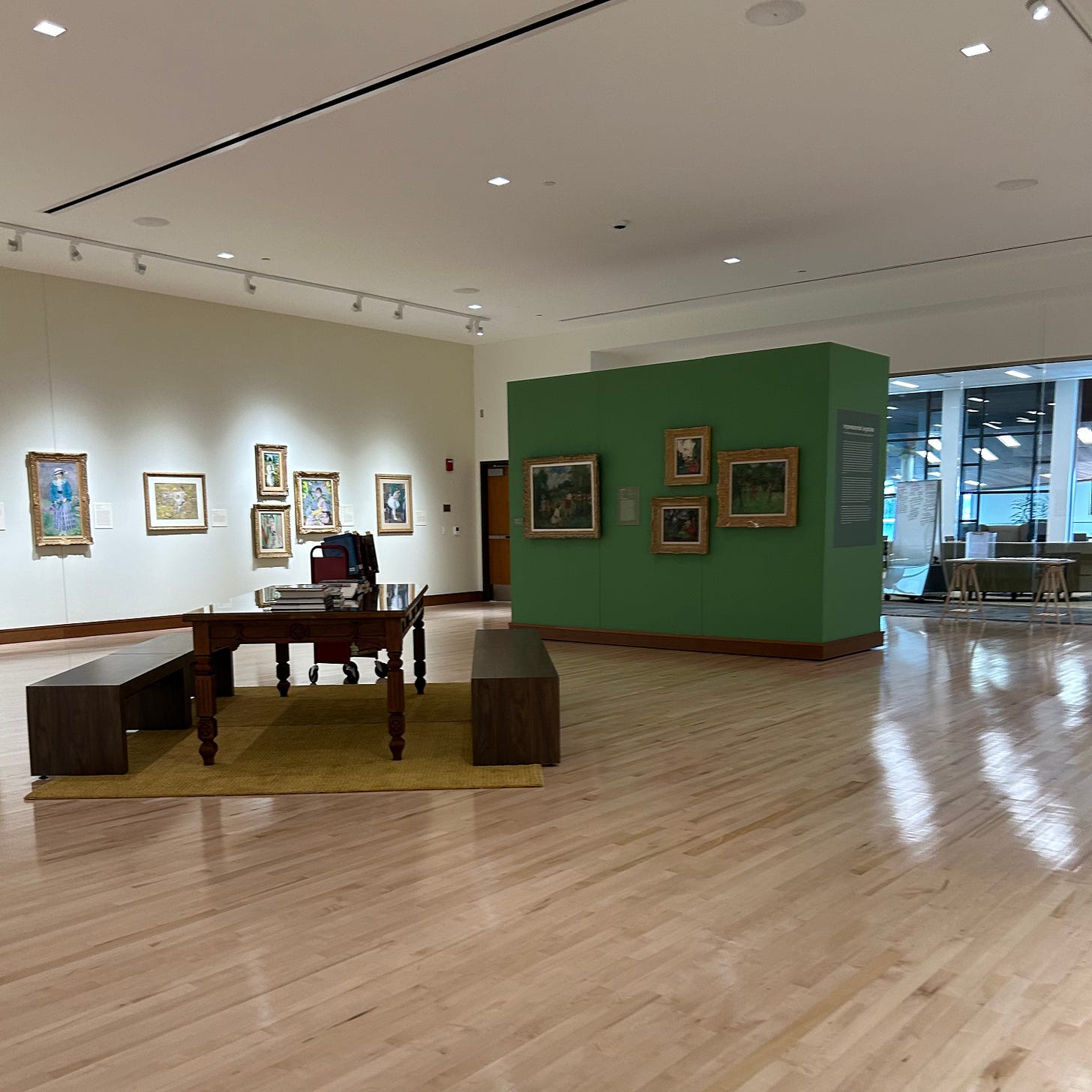Where'd All the Art Majors Go?
Declining enrollment in art programs at higher educational institutions is a symptom of devaluing the arts across the United States and a lack of creative capital at large
In 2017, I was one of nine Studio Art majors in the approximately 400 graduating class total at my small liberal arts college in Pennsylvania. Back then, our college had two and a half rooms dedicated to studio art courses. The half room was made by the courtesy of our drawing and painting instructor, who gave up a portion of his office space to squeeze in the kiln and an additional pottery wheel or two. There were probably only six pottery wheels to begin with and the other four were kept near the entrance of the second room at the end of our 30-something-foot hallway. The space we were allotted as art majors—even though we were few—was minimal, but we made the most of it. Working in close proximity of my peers had its benefits and its burdens. The benefits were intimate moments of inspiration, opportunities to closely witness one another develop our art and as artists, regular exchanging of ideas bouncing off each other, and articulations of criticisms that were personalized, not personal, because we knew one another well enough to challenge, but never insult. The burdens were scarcity of storage spaces or of space generally, an underlying comparison competition evaluating how each other’s art and artistry stacked up to one another, frequent encroachment of boundaries that created a feeling of being constantly on display, and an overall lack of resources where knowing concessions were made by who-got-what-when and over what and how courses were taught. Even the gallery, where all nine of us would inevitably showcase our artworks in our degree-required capstone senior exhibitions, could not accommodate the whole class, which contributed to further schisms in time and in between classmates. And yet, in light of recent closures of art schools, shrinking of art programs at colleges, cutting-back of public art education, and a general decline in the value and appreciation of the arts in the United States—I could not be more grateful for the space, however limited, I had as an art major.
The announcement this week that the Pennsylvania Academy of Fine Arts (PAFA) is eliminating its Bachelor of Fine Arts (BFA) and Master of Fine Arts (MFA) degree programs by 2025 should shock the collective consciouses not only to the decline in arts education broadly, but also to the valuation by way of breadth of opportunity in higher education in the United States. PAFA is a pillar for the history of art in the United States as the first art museum and first art school in the nation. Founded in 1805, PAFA is among one of the country’s oldest institutions and was established within the City of Philadelphia where the United States declared its independence from Britain just shy of 30 years prior. Leading in both art and freedom, PAFA recognized the rights to equal education between the sexes by admitting women to study and participate in classes earlier than most other colleges, universities, and academies here and abroad, which refused the same. As such, PAFA formed the launching ground for many storied artists throughout the 19th, 20th, and 21st century, the likes of which include a former Pittsburgh-area resident, Mary Cassatt, the parents of Dauphin County-born artist Alexander Calder, Alexander Stirling and Nanette Calder, who were respected sculptor and painter in their own right, and a Nicetown-Tioga Philadelphia neighborhood native, Barkley L. Hendricks. PAFA’s BFA and MFA degree programs were much newer to the historic institution’s repertoire, introduced independently at the academy around the late 1990s to mid-2000s. Nevertheless, the elimination of these academic offerings from an institution of such esteem for reasons cited by PAFA’s President, Eric Pryor, as “rising costs,” “dwindling enrollment,” and “growing systemic obstacles confronting degree-granting programs” ought to send shivers up the spine of those schools and colleges that are less endowed. Especially given that PAFA and its leadership apparently “sought every possible opportunity” to avoid the rendered outcome, “established a Long-Term Sustainability group,” “developed blueprints,” “conducted extensive outreach to potential partners,” left “no stone unturned,” and yet “[t]hese efforts did not bear fruit.”
So, the question becomes if the United States’ oldest and longest-lasting art institution cannot justify retaining its art degree programs even after doing everything possible to save them, is there hope in pursuing higher education in the arts at all anymore? Steeper still, is PAFA’s elimination of its BFA and MFA programs a singular failure by a limited set of circumstances at one institution or a symptom of the wider systemic issues in the United States around the arts, education, and the corporate structure of art and educational organizations?
This wave of news regarding PAFA reminded me of a similar storyline from 2019. After graduating with my Bachelor of Arts in Studio Art, I decided to continue my education at a law school in the capital of the United States. It was an unconventional route with someone of my educational background; however, the motivation I carry in pursuing both art and law is best articulated in paraphrasing the former President John F. Kennedy such that if more artists knew law and more lawyers knew art, I believe the world would be a more just place to live. So, in March 2019, I was completing my first-year of legal studies when news outlets from my hometown area reported that the Art Institute of Pittsburgh (Ai Pittsburgh) closed its doors causing its students and faculty to face unknowing futures with little to no direction or guidance from the Institute’s leadership. Like PAFA, Ai Pittsburgh was a seminal institution. Founded in 1921 by Willis D. Shook, a Wilkinsburg man with a dream, Ai Pittsburgh began simply, offering an affordable, two-year art school program in art and illustration. Shook lead the institution into the 1960s, until it was sold to a Pennsylvania-based corporate entity, Education Management Corporation (EDMC) in 1969. From there, the institution grew exponentially over the years amassing campuses in other major United States cities, expanding its course offerings to include game design, audio and film production, fashion, and culinary arts, and reaching a record enrollment of 100,000 students in the early 2000s. However, in 2015, EDMC faced the legal music by way of a $95.5 million dollar settlement with the United States Department of Justice—the largest ever in a higher education false claims case—for violations under the Incentive Compensation Ban in the Higher Education Act involving illegal enrollment practices and allegations of fraud under the False Claims Act. Later, EDMC sold the Art Institutes it owned to Dream Center Foundation (DCF), the parent company of Dream Center Education Holdings, LLC (DCEH), who ultimately owned and operated the institutions after the 2017 sale. Further legal ramifications ensued the following year when in 2018, Art Institute students filed a class-action lawsuit against DCEH alleging that it made false and misleading representations to students regarding the accreditation status of its institutions for nearly half a year, while students continued to pay tuition and incur debt for unaccredited courses and degrees. Shortly thereafter, DCEH and the related Art Institutes, which included Ai Pittsburgh, agreed to be placed in a federal receivership to protect its funds from creditors. Within days of his appointment, the court appointed federal receiver, Mark Dottore, attempted to find a buyer to take control of Ai Pittsburgh, and the other Art Institutes, but whatever possibility was there came to a hasty halt once funds ran out and enrollment ended. Following Ai Pittsburgh’s 2019 closure, several Art Institutes in other cities survived. Then, just last year in September 2023, the last eight remaining institutions were permanently closed citing similar causes like declining enrollment and financial hardship, resulting in “a culmination of events of the past decade…[that] forced the closure of this system of colleges.”
The fact that many non-art-only institutions are also experiencing declining enrollment in recent years due to the pandemic, and yet PAFA and Ai Pittsburgh both relied on this disruption as a justification for either eliminating or closing their respected programs and schools raises concerns for a number of reasons, but it also begs the question of why are students no longer choosing to pursue arts programs in higher education? This is, in my view, an age-old problem. A problem that Pablo Picasso articulately described as “Every child is an artist. The problem is how to remain an artist once we grow up.” Our education systems in the United States do not prioritize the arts by any means. Think about the standardized tests that are required in early public education schools across the nation and for admittance into US colleges and universities—how many of those tests are asking students to draw a picture, play an instrument, recite a monologue, or perform a waltz? Zero. As Sir Ken Robinson stated in his 2006 TED Talk, “Do schools kill creativity?” (which I always mistakenly call “How schools kills creativity” because this is no longer a question to me), “What happens is, as children grow up, we start to educate them progressively from the waist up. And then we focus on their heads. And slightly to one side.” He continued, “Our education system is predicated on the idea of academic ability. And there’s a reason. Around the world, there were no public systems of education, really, before the 19th century. They all came into being to meet the needs of industrialism. So the hierarchy is rooted on two ideas.
Number one, that the most useful subjects for work are at the top. So you were probably steered benignly away from things at school when you were a kid, things you liked, on the grounds that you would never get a job doing that. Is that right? Don’t do music, you’re not going to be a musician; don’t do art, you won’t be an artist. Benign advice — now, profoundly mistaken. The whole world is engulfed in a revolution.
And the second is academic ability, which has really come to dominate our view of intelligence, because the universities designed the system in their image. If you think of it, the whole system of public education around the world is a protracted process of university entrance. And the consequence is that many highly-talented, brilliant, creative people think they’re not, because the thing they were good at at school wasn’t valued, or was actually stigmatized. And I think we can’t afford to go on that way.”
By failing to place the appropriate value on an arts education early on in elementary, middle, and high school it is no wonder that 18-year-olds are not interested in enrolling in art programs or art schools in higher educational institutions at the college and university level. Pursuing art is portrayed as an unrealistic option because it is not engrained in our STEM-society that it is valued as such. Routinely, even before the financial constraints caused by pandemic, art classes in primary public education environments were underfunded, constricted by budget cuts, and regarded as electives rather than core components of the curriculum. All of this adds to the stereotype that art is hobby, not a career and that art does not have educational value beyond childhood. Sadly then, students who are interested in the arts starve for education in these areas, choosing either not to pursue higher education at all or to pursue higher education in an unrelated field, thus either way the nation loses out on the potential creative capital that could be generated if the education, resources, and talent were harness appropriately.
Looking at the art market specifically, the National Endowment for the Arts (NEA) reported that in 2021, the arts contributed roughly $1 trillion dollars or 4.4% to the United States Gross Domestic Product (GDP), out performing the transportation, tourism, and agricultural industries, which are areas the arts contribute across by way of attracting domestic and international audiences and supporting local community businesses. The organization, Americans for the Arts reports that annually, nonprofit arts organizations generate upwards of $135 billion dollars to the US economy, supporting 4.1 million jobs, raising $22.3 billion dollars in government revenue, and providing research and development to the larger for-profit arts sector. Last year, artnet’s 2023 midyear review signified a downward trend in terms of art sales from previous pandemic highs, with the top value artworks priced above $10 million dollars shrinking considerably by 51% and those bottom value artworks priced at $10,000 dollars or under shrinking by 12%. These estimates present hard data on the valuation of the arts in terms of dollars and cents, an important indicator for tracing potential creative capital trends. However, further valuation can and should be analyzed and incorporated with these figures related to the value the arts contribute to the progress of society at large through creative-problem solving, emotional intelligence, and individual well-being.
The building complex along Pittsburgh’s Strip District that once hosted courses ranging from drawing, game design, illustration, fashion and culinary arts now sits empty as a shell of Ai Pittsburgh’s owner Dream Center Education Holdings, LLC and a relic of its founder’s original dream. In time, those students and staff which are most immediately impacted by the elimination of their art degree programs and the closure of their art school, will inevitably find new opportunities at nearby colleges, universities, academies and employers, unsure whether better or worse than the opportunities that could have been had their program or school continued. Perhaps, in part, Ai Pittsburgh’s closure was a mess of its own making—a result of mismanagement in the corporate organizational structure. Although a wider look at the situation that happened with two formative Pennsylvania art schools suggests a deeper-seeded issue, particularly one that declares the value of having (and saving) an arts education—despite efforts to avoid its erasure—is matter-of-factly not worth it anymore. That, of course, is the bleakest interpretation of these circumstances.
After-all, these institutions had their heydays, too. Lest we forget the number of great influential artists they formed and the multitude of artworks produced as a result of creating space of those artists to be educated that our society now reaps the benefits of on the walls of prestigious museums, the screens of our theaters and devices, the stacks of our libraries, and the stages of our performance halls. The title of this post harks to the words of Jack Johnson’s song “Good People,” inquisitively asking “Where did all the good people go” and reminding us that “We got heaps and heaps of what we sow.” Devaluing the arts does a disservice to economy and society. If we continue to eliminate our art programs and close our art schools, the consequence of what else we could lose in terms of art is a picture of the world I do not wish to see.
Recently, I returned to my undergraduate alma mater where in the over five years since my attendance there my small liberal arts college has thankfully expanded its art offerings in terms of courses and spaces. A spacious new gallery housed on campus hosts permanent collections and plenty of space for students to showcase their artwork. The old gallery is being repurposed for photography studios and the two and a half classrooms downstairs are now practically three full-sized spaces, complete with large tabletops for drawing, additional pottery wheels that fit together comfortably, a designated stained-glass making shelf, and plenty of storage for the next generation of art majors to go through here. In a world that is increasingly constricting the amount of space artists can fill, finding those institutions that help artists flourish are rare, but required.
Gina McKlveen is the writer and visionary behind imaginartist. She graduated from Saint Vincent College in 2017 with dual Bachelor of Arts degrees in Studio Art and English with a concentration in Literature and Politics. In 2021, she graduated from The George Washington University Law School where she focused her studies in Intellectual Property Law and did not abandon her love for the arts. Gina currently resides in Pennsylvania where she is both a practicing attorney and artist.






